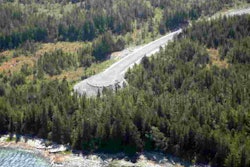 UDOT crews work on an I-84 overpass, using geosynthetic reinforcement and soil integration in place of steel pylons and concrete. (Photo: Jeffrey D. Allred, Deseret News)
UDOT crews work on an I-84 overpass, using geosynthetic reinforcement and soil integration in place of steel pylons and concrete. (Photo: Jeffrey D. Allred, Deseret News)The Utah Department of Transportation (UDOT) is using a new bridge-building method involving geosynthetic reinforcement and soil integration to replace an Interstate 84 overpass near Echo Junction, according to a report from Deseret News.
UDOT is the first agency in the U.S. to use this innovative technique, which is intended to save time and money for Utah travelers and taxpayers.
Tim Rose, UDOT Region 2 deputy director, told Deseret News that the agency “is just building a bridge abutment out of soil and reinforcement” rather than the traditional bridge design, which uses steel pylons and concrete.
The footing for the 58-foot-wide span will consist of multiple layers of compressed dirt. A fabric much like tarp will separate each layer.
Crews will build each portion of the abutment in three steps: laying the block, adding and compacting the backfill and placing the geosynthetic reinforcement.
UDOT officials said they expect the new method to save about $200,000 because crews won’t have to wait 28 days for concrete to cure. The project will cost $3.2 million.
The Federal Highway Administration (FHWA) noted that geosynthetic reinforcement generally lowers the cost of non-interstate bridges by 30 percent to 60 percent.
According to the Deseret News report, fewer materials, faster construction and less equipment help reduce construction costs. Additionally, the structure requires less maintenance than traditionally-built bridges and is not affected by changes in the weather, lowering long-term costs.
Rose added that the elimination of equipment staging and material delivery, ability to work in most weather conditions and use of a small crew also contribute to cost savings.
The only bridge closure will take place next month, when crews move the bridge into place.









